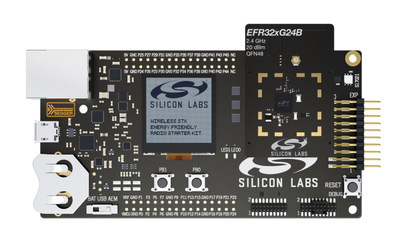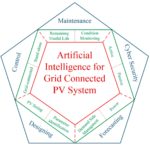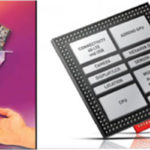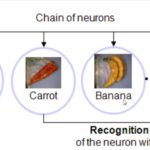Silicon Labs announced the BG24 and MG24 families of 2.4 GHz wireless SoCs for Bluetooth and Multiple-protocol operations, respectively, and a new software toolkit. This new co-optimized hardware and software platform will help bring AI/ML applications and wireless high performance to battery-powered edge devices. Matter-ready, the ultra-low-power BG24, and MG24 families support multiple wireless protocols and incorporate PSA Level 3 Secure Vault protection, ideal for diverse smart home, medical and industrial applications.
The SoC and software solution for the Internet of Things (IoT) includes: Two new families of 2.4 GHz wireless SoCs, which feature the industry’s first integrated AI/ML accelerators, support for Matter, Zigbee, OpenThread, Bluetooth Low Energy, Bluetooth mesh, proprietary and multi-protocol operation, the highest level of industry security certification, ultra-low power capabilities and the largest memory and flash capacity in the Silicon Labs portfolio. A new software toolkit designed to allow developers to quickly build and deploy AI and machine learning algorithms using some of the most popular tool suites like TensorFlow.
IoT product designers see the tremendous potential of AI and machine learning to bring even greater intelligence to edge applications like home security systems, wearable medical monitors, sensors monitoring commercial facilities and industrial equipment, and more. But today, those considering deploying AI or machine learning at the edge are faced with steep penalties in performance and energy use that may outweigh the benefits.
The BG24 and MG24 alleviate those penalties as the first ultra-low powered devices with dedicated AI/ML accelerators built-in. This specialized hardware is designed to handle complex calculations quickly and efficiently, with internal testing showing up to a 4x improvement in performance along with up to a 6x improvement in energy efficiency. Because the ML calculations are happening on the local device rather than in the cloud, network latency is eliminated for faster decision-making and actions.
The BG24 and MG24 families also have the largest Flash and random access memory (RAM) capacities in the Silicon Labs portfolio. This means that the device can evolve for multi-protocol support, Matter, and trained ML algorithms for large datasets. PSA Level 3-Certified Secure Vault, the highest level of security certification for IoT devices, provides the security needed in products like door locks, medical equipment, and other sensitive deployments where hardening the device from external threats is paramount.
In addition to natively supporting TensorFlow, Silicon Labs has partnered with some of the leading AI and ML tools providers, like SensiML and Edge Impulse, to ensure that developers have an end-to-end toolchain that simplifies the development of machine learning models optimized for embedded deployments of wireless applications. Using this new AI/ML toolchain with Silicon Labs’s Simplicity Studio and the BG24 and MG24 families of SoCs, developers can create applications that draw information from various connected devices, all communicating with each other using Matter to then make intelligent machine learning-driven decisions.
For example, in a commercial office building, many lights are controlled by motion detectors that monitor occupancy to determine if the lights should be on or off. However, when typing at a desk with motion limited to hands and fingers, workers may be left in the dark when motion sensors alone cannot recognize their presence. By connecting audio sensors with motion detectors through the Matter application layer, the additional audio data, such as the sound of typing, can be run through a machine-learning algorithm to allow the lighting system to make a more informed decision about whether the lights should be on or off.
ML computing at the edge enables other intelligent industrial and home applications, including sensor-data processing for anomaly detection, predictive maintenance, audio pattern recognition for improved glass-break detection, simple-command word recognition, and vision use cases like presence detection or people counting with low-resolution cameras.
More than 40 companies representing various industries and applications have already begun developing and testing this new platform solution in a closed Alpha program. These companies have been drawn to the BG24 and MG24 platforms by their ultra-low power, advanced features, including AI/ML capabilities and support for Matter. Global retailers are looking to improve the in-store shopping experience with more accurate asset tracking, real-time price updating, and other uses. Participants from the commercial building management sector are exploring how to make their building systems, including lighting and HVAC, more intelligent to lower owners’ costs and reduce their environmental footprint. Finally, consumer and smart home solution providers are working to make it easier to connect various devices and expand the way they interact to bring innovative new features and services to consumers.
The single-die BG24 and MG24 SoCs combine a 78 MHz ARM Cortex-M33 processor, high-performance 2.4 GHz radio, industry-leading 20-bit ADC, an optimized combination of Flash (up to 1536 kB) and RAM (up to 256 kB), and an AI/ML hardware accelerator for processing machine learning algorithms while offloading the ARM Cortex-M33, so applications have more cycles to do other work. Supporting a broad range of 2.4 GHz wireless IoT protocols, these SoCs incorporate the highest security with the best RF performance/energy-efficiency ratio in the market.
EFR32BG24 and EFR32MG24 SoCs in 5 mm x 5 mm QFN40 and 6 mm x 6 mm QFN48 packages are shipping today to Alpha customers and will be available for mass deployment in April 2022. Multiple evaluation boards are available to designers developing applications. Modules based on the BG24 and MG24 SoCs will be available in the second half of 2022.







